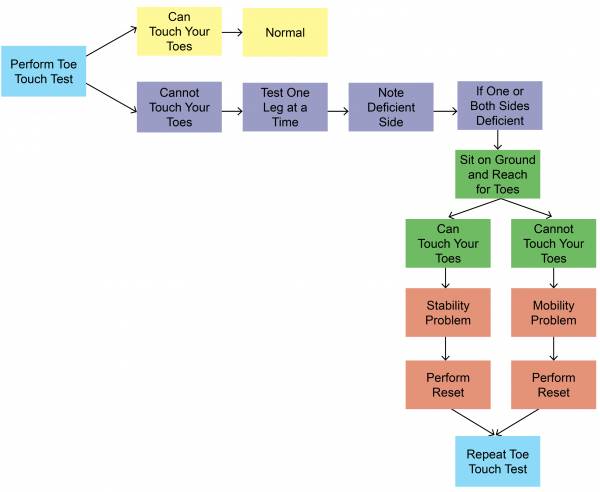Stand with your feet together. Keep your knees locked. Slowly bend forward and touch your toes. Can you reach them? If not, that means your hamstrings are too tight and they need stretching.
Wait. Not so fast.
Just because the hamstrings are tight doesn’t mean they need stretching. Always look deeper before stretching anything. There are many different reasons you can’t touch your toes. Let’s examine the issues.
Decreased mobility and poor stability force your body to compensate with problematic movement patterns.
The Standing Toe Touch
The standing toe touch test is part of a breakout series of movements from the Selective Functional Movement Assessment (SFMA) created by Gray Cook, Greg Rose, and Kyle Kiesel. It’s one of seven fundamental patterns based on the premise of regional interdependence. This is a fancy way to say that everything is connected, and everything matters. The SFMA system looks at movement patterning to determine if you should be going down the mobility or stability rabbit hole.
When a hip is locked down due to decreased mobility, hinging at the hip joint efficiently becomes difficult. The body will put the brakes on the movement and take the path of least resistance, demanding more movement from the lower back. Overuse of the lower back will leave you more prone to pain and injury. So how can you determine which hip is involved? Or is it both? To find the answer, break out the hips one at a time in the toe touch:
- Put your feet together.
- Stand with your knees locked.
- Slowly bend forward and try to touch your toes with your hands.
Either:
- You can touch your toes. That is what we want.
- You can’t touch your toes. We need to determine if it’s a problem with hip mobility and/or pelvis mobility, or a matter of stability restriction.
Standing Assessment
The test requires no equipment. Simply begin from a standing position.
- Put your feet together.
- Shift your weight to the left leg, keeping it straight. Unlock your knee on the right side and go on the ball of your foot. All the weight should be on your left leg.
- Stack your hands on top of one another.
- Slowly bend forward, aiming towards your left toes. Note how far you go.
- Now switch positions. Shift your weight to the right.
- The right leg goes straight with knee locked.
- Bend the left knee and go on the ball of your left foot. Slowly bend forward and aim towards the right foot.
How did it feel? Did you go further on one side than the other? If the range of motion is less on one side, this indicates hip involvement. If you have the same range of motion on both sides, then both hips and/or the lower back region may be involved.
Seated Assessment
Now we go to the ground to see if range of motion changes in a seated position.
- Sit down on the ground with legs in front, knees and feet together.
- Slowly bend forward to touch your toes.
- Do you get further?
Is Mobility a Restriction?
If you stay the same, you may have a mobility issue in the lower back/pelvis/hips or tissue tightening on the hamstrings. Mobility restrictions will remain no matter what position you get into. Without proper hip hinge mobility, you will overuse the lower back and be more prone to injury. Reduced hip hinge results in less involvement of the powerhouse gluteus maximus muscle.
Use my RAIL Neural Reset System for your mobility restriction. RAIL stands for release, activate, integrate, and locomotion.
- Release the hip and buttock region with foam rolling. A few minutes is enough.
- Release the hip joint with an elastic band.
- Activate/Integrate the pattern of hip and back chain with cross-body patterning on the ground. Do four repetitions total, two on each side. Go slowly, with mindful movement and controlled concentric and eccentric motion. Completely relax after each repetition.
- Locomotion: Stand up and walk.
After the reset, repeat the toe touch test and see if anything has changed.
Do You Have Sub-Par Stability?
If you were able to get further, this indicates an underlying stability dysfunction. When you sit on the ground, you become more stable and the nervous system allows more movement because it feels safer. Poor stability (motor control) means decreased timing and rhythm in movements. Altered motor control takes more effort, so durability and performance take a hit.
- Activate/Integrate the pattern of hip and back chain with cross-body patterning on the ground. Do four repetitions total, two on each side. Go slowly, with mindful movement and controlled concentric and eccentric motion. Completely relax after each repetition.
- Locomotion: Stand up and walk.
After the reset, repeat the toe touch test and see if anything has changed.
Summary
Perform the toe touch test and follow the chart to determine a course of action for establishing better movement patterns.

You’ll Also Enjoy:
- Stretching Your Hamstrings Isn’t Always Best
- Hamstrings 101: Start by Stretching your Back
- Are Your Weak Neck Muscles Making Your Hamstrings Tight?
- New on Breaking Muscle Right Now
Photo courtesy of Shutterstock.






